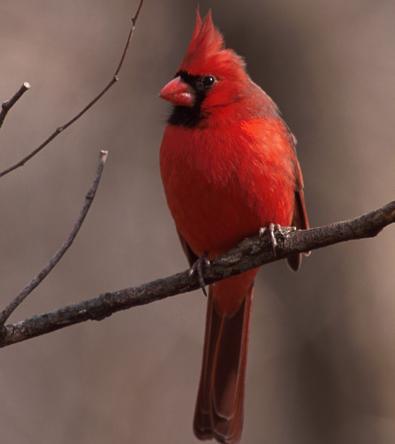Cardinal - Northern
Northern Cardinal Scientific Name: Cardinalis cardinalis
Tue, 29th April, 2025 - 10:08 pm GMT
Sponsor Ads:

Alternative Name
Northern Cardinal Scientific Name: Cardinalis cardinalisBasic Info
The Northern Cardinal is a medium-sized bird, measuring approximately 22 centimeters, eight and a half inches, in length from beak-tip to tail-tip. Males are usually a bright red with a black mask on the face. Females tend to be a glossy brown or olive color that is tinged red on the tail, wings, and crest. The female lacks the black mask donned by the male, but parts of the face may be dark. Both sexes have distinctive crest atop their head and a thick, pointed bill, which begins black as a fledgling and then turns a reddish color with age.
Health
Breeding The Northern Cardinal is known to mate for life. Their breeding season begins in late March and extends through early August, peaking in May. Most Cardinals prefer to breed in shrubby areas or thickets 1-15 feet above the ground. The nest is constructed by both sexes and is cup-shaped. It is made from stems, twigs, grass, bark strips, and other plant material. Female Cardinals will usually bear two sets of offspring, the first being around early March, and the second around late May to early July. After mating, the female will lay two to five white to greenish eggs, the average being four eggs, which are about an inch in length and an inch and a half in diameter. She will, then, incubate the eggs for approximately 12-13 days. Once hatched, both parents care for the offspring. At approximately 9-10 days after hatching, the fledglings will leave the nest, but will remain dependent upon their parents for two to four more weeks. The father usually cares for the offspring during this time while the mother starts the next nest. The Cardinal will generally have two broods each year.Habitat
N/ABehavior
The Northern Cardinal is a very popular North American bird, seen by multitudes of birdwatchers. It is also the state bird of seven states. The Northern Cardinal is not a migratory bird. This bird tends to make its home on the edges of woods, hedgerows, and in vegetation around houses.This bird also has a very distinct and beautiful call consisting of varied whistled notes that are often described as sounding like "cheer-cheer-cheer" or "purty-purty-purty." This call has placed the Cardinal under the title of "song-bird." Cardinals are generally attracted to a wide range of plants, both for cover and for food. If you wish to attract Cardinals to your yard it is important to have a lot of plants, vines and shrubs, such as American Bittersweet, Raspberry, Sumac, Conifers, American arborvitae, and Hawthorn to name just a few. They are also very attracted to winter and fall fruits. You should also provide water for bathing and drinking. The addition of water will also encourage them to start nesting in your yard.Origin
North AmericaHistory
Early settlers were said to have named this bird after the Cardinal of the Catholic Church because the red of the bird reminded them of the color of the Cardinal's robes. Since 1886, the Cardinal has considerably expanded its territory from being rarely seen north of the Ohio River to thriving over much of North America. The Northern Cardinal is quite similar to the Pyrrhuloxia, which is a southwestern species that is mostly gray with a crest tipped in red.Common Foods
Cardinals love to eat sunflower seeds, and are commonly encouraged to live near houses by people placing sunflower seed feeders in their front and back yards. When sunflower seeds are not available, Cardinals will eat weed seeds, grains, insects, and fruSponsor Ads:
Money is how people with no talent keep score. -- Michael Hart, Brief History of the Internet, 1995
Cardinal - Northern
Coded by: BGID® | ALL RIGHTS RESERVED Copyright © 2000-2025
Disclaimer | Privacy | Report Errors / Contact | Credits

 President of the United States of America - Real Estate mogul, Pageant owner and now one of the most controversial men in political history.
President of the United States of America - Real Estate mogul, Pageant owner and now one of the most controversial men in political history.  Politician, US Vice President and President of the USA - Joseph Robinette Biden Jr.
Politician, US Vice President and President of the USA - Joseph Robinette Biden Jr.  versus
versus  Russia: 'The Evil Empire'? Are they all that bad or is it just the USA trying to portray Russia as bad because they are a world power with land bigger and a society very different from the USA ideal?
Russia: 'The Evil Empire'? Are they all that bad or is it just the USA trying to portray Russia as bad because they are a world power with land bigger and a society very different from the USA ideal?  Global warming has been in and out as the "latest" hot topic for many years. It is, according to modern scientists, the result of man-made industrial pollutants, clearing forested areas, agriculture, etc. But now they are thinking it started way before the Industrial Revolution...
Global warming has been in and out as the "latest" hot topic for many years. It is, according to modern scientists, the result of man-made industrial pollutants, clearing forested areas, agriculture, etc. But now they are thinking it started way before the Industrial Revolution... 
 Corona virus
Corona virus 
 Users with wide screen monitors can benefit from more content on every page.
Users with wide screen monitors can benefit from more content on every page.